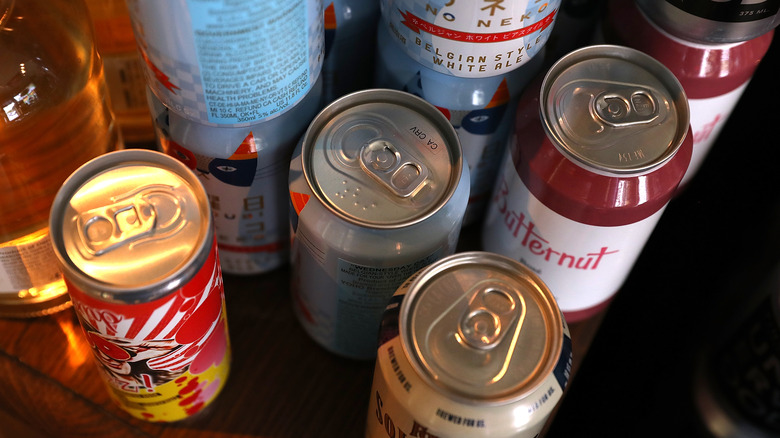Why The Earliest Canned Wines In The US Were A Major Fail
Canned wine has gone from novelty to liquor store staple, but this current wave of aluminum-clad vino isn't the country's first. The emergence of popular canned wine over the last few decades seems like a triumph of modern convenience and a more relaxed attitude towards a product that is traditionally seen as stuffy, but it's actually a story of technology. Canned wine was first brought to the U.S. market hot on the heels of Prohibition, with the first brands being released in 1935, the same year the first canned beer was introduced. The first problem was that the wine was generally poor quality; This was a beer country, but the bigger issue was with the cans themselves. Not only were the cans flat-topped and hard to open, but they were made from steel, which is reactive. To protect the wine from the steel, the cans were lined on the inside. However, the acidic wine corroded the coating, giving everything a pretty nasty flavor.
One issue that made the canning problem even worse was the lingering effects of Prohibition. Winemaking had been decimated by the alcohol ban, and most wine was being home-produced. The only popular commercial brands that survived were sweet, highly fortified wines like sherry, which couldn't be made at home. So port, sherry, and muscatel sweet wines were the ones that were first canned by wine companies. The problem is these wines have an even higher alcohol content than dry wine and are even more corrosive.
A canned wine breakthrough came in the 1900s
These initial failures stunted canned wine for decades. There were some canned wines with screw-top caps that were easier to open and released by local companies in the 40s and 50s, but they were all quick to disappear. A Colorado company took on the corrosive high-alcohol problem by pioneering wine coolers in the 50s, and that too ended in failure. However, wine coolers proved to be the first breakthrough, as other brands gained traction in the late 70s and helped raise interest in canned wine again. Yet full success proved to be elusive as the canning problem reared its head. Coca-Cola invested big in the Taylor Wine Company, and tested out canned wine as a convenient, space-saving option for the airline industry in styles like Burgundy and Chablis. Turns out customers still hated canned wines that weren't coolers, and complaints about its metallic flavors led to a rapid abandonment of the program.
There was a breakthrough when nonreactive linings that worked with wine were finally developed in the 90s, but public perception was tainted by old failures. Only the celebrity star power of director Francis Ford Coppola finally convinced some people to give canned wine another shot. His Sofia Blanc de Blancs sparkling wine, named after his also famous daughter, was aimed at young customers and became a hit. Its success turned people on to the progress canned wine technology had finally made, and opened the door for the current boom.

